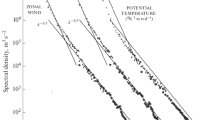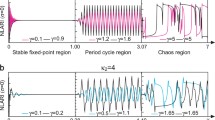Abstract
We present the extension of a deterministic fractal geometric procedure aimed at representing the complexity of patterns encountered in environmental applications. The procedure, which is based on transformations of multifractal distributions via fractal functions, is extended through the introduction of nonlinear perturbations in the generating iterated linear maps. We demonstrate, by means of various simulations based on changes in parameters, that the nonlinear perturbations generate yet a richer collection of interesting patterns, as reflected by their overall shapes and their statistical and multifractal properties. It is shown that the nonlinear extensions yield structures that closely resemble complex hydrologic spatio-temporal datasets, such as rainfall and runoff time series, and width-functions of river networks. The implications of this nonlinear approach for environmental modeling and prediction are discussed.











Similar content being viewed by others
References
Barnsley MF (1986) Fractal functions and interpolation. Constr Approx 2:303–329
Barnsley MF (1988) Fractals everywhere. Academic Press, New York
Box G, Jenkins GM, Reinsel G (1994) Time series analysis: forecasting and control. Prentice-Hall, New York
Lorenz EN (1963) Deterministic nonperiodic flow. J Atmos Sci 20:130–141
Mandelbrot BB (1983) The fractal geometry of nature. Freeman, New York
Mandelbrot BB (1989) Multifractal measures especially for the geophysicist. In: Scholz CH, Mandelbrot MM (eds) Fractals in geophysics. Birkhauser Verlag, Basel, pp 1–42
Meneveau C, Sreenivasan KR (1987) Simple multifractal cascade model for fully developed turbulence. Phys Rev Lett 59:1424–1427
Obregón N, Puente CE, Sivakumar B (2002a) Modeling high resolution rain rates via a deterministic fractal–multifractal approach. Fractals 10(3):387–394
Obregón N, Sivakumar B, Puente CE (2002b) A deterministic geometric representation of temporal rainfall. Sensitivity analysis for a storm in Boston. J Hydrol 269(3–4):224–235
Puente CE (1992) Multinomial multifractals, fractal interpolators, and the Gaussian distribution. Phys Lett A 161:441–447
Puente CE (1994) Deterministic fractal geometry and probability. Int J Bifurcat Chaos 4(6):1613–1629
Puente CE (1996) A new approach to hydrologic modeling: Derived distributions revisited. J Hydrol 187:65–80
Puente CE (2004) A universe projections: may Plato be right? Chaos Solitons Fractals 19(2):241–253
Puente CE, Obregón N (1996) A deterministic geometric representation of temporal rainfall. Results for a storm in Boston. Water Resour Res 32(9):2825–2839
Puente CE, Obregón N (1999) A geometric Platonic approach to multifractality and turbulence. Fractals 7(4):403–420
Puente CE, Sivakumar B (2003) A deterministic width function model. Nonlinear Process Geophys 10:525–529
Puente CE, Sivakumar B (2007) Modeling hydrologic complexity: a case for geometric determinism. Hydrol Earth Syst Sci 11:721–724
Puente CE, López MM, Pinzón JE, Angulo JM (1996) The Gaussian distribution revisited. Adv Appl Prob 28(2):500–524
Puente CE, Obregón N, Robayo O, Juliao MG, Simsek D (1999) Projections of fractal functions: a new vision to nature’s complexity. Fractals 7(4):387–401
Puente CE, Robayo O, Díaz MC, Sivakumar B (2001a) A fractal–multifractal approach to groundwater contamination. 1. Modeling conservative tracers at the Borden site. Stoch Environ Res Risk Assess 15(5):357–371
Puente CE, Robayo O, Sivakumar B (2001b) A fractal–multifractal approach to groundwater contamination. 2. Predicting conservative tracers at the Borden site. Stoch Environ Res Risk Assess 15(5):372–383
Rodríguez-Iturbe I, De Power FB, Sharifi MB, Georgakakos KP (1989) Chaos in rainfall. Water Resour Res 25(7):1667–1675
Yaglom AM (1987) Correlation theory of stationary and related random functions. Springer, New York
Acknowledgments
This work was supported in part by the Director, Office of Science, of the US Department of Energy under Contract No. DE-AC02-05CH11231.
Author information
Authors and Affiliations
Corresponding author
Rights and permissions
About this article
Cite this article
Cortis, A., Puente, C.E. & Sivakumar, B. Nonlinear extensions of a fractal–multifractal approach for environmental modeling. Stoch Environ Res Risk Assess 23, 897–906 (2009). https://doi.org/10.1007/s00477-008-0272-0
Published:
Issue Date:
DOI: https://doi.org/10.1007/s00477-008-0272-0




